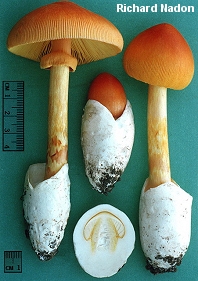|
Amanita identification often begins with the base of the stem, which means that you will need to dig your specimens out of the ground with a pocket knife. Do this carefully, because some of the potentially important features are fragile and easily destroyed. The shape of the stem base is important. Is there a bulb, or does the stem taper gradually? If there is a bulb, is it dramatic, or less abruptly swollen? Does the stem "radicate," forming a root that extends into the ground? Also important is the disposition of the universal veil, which can vary substantially. Here are illustrations of some of the classic amanita stem bases:
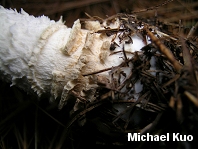
"Muscaria-like" base with
concentric zones of shagginess.
|
|
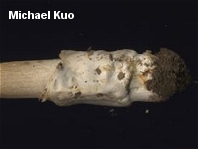
Sack-like volva; base not swollen.
|
|
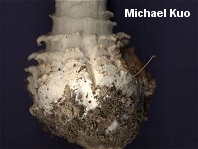
Swollen base with bent-back ("recurved") scales.
|
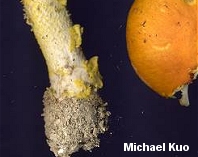
Indistinct stem base with
adhering volva fragments.
|
|

Sack-like volva, swollen base.
|
|
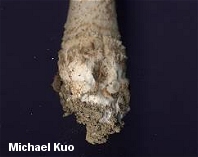
Indistinct base.
|
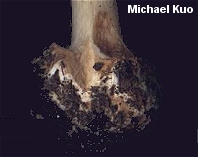
"Cleft" or chiseled basal bulb.
|
|

Swollen base with collar and rim.
|
|

Abrupt bulb with a rim.
|
Further up the stem, look for a ring; many amanitas have a partial veil that leaves a ring on the stem, but some, like members of the Amanita vaginata species group, do not. Note whether or not the ring is fragile and ephemeral, or sturdy--and whether it develops stains or discolorations. A few amanitas are "rubescent"--the term in Mycologese for mushrooms that blush pink or reddish when bruised, or develop reddish discolorations with age. Amanita rubescens and Amanita novinupta are among the most commonly encountered "blushers." Some species bruise and discolor brown, like Amanita brunnescens, whose chiseled stem base is illustrated above. The color of the cap is of course important, as is the cap margin, which may be lined with prominent striations. The universal veil is often evident on the cap, in the form of warts or patches. Some amanitas have characteristic odors, but you should not attempt to determine the taste of your Amanita specimen; there is no instance in the entire genus where taste is the sole informative character that separates two species, and tasting amanitas is dangerous. Microscopic characters are sometimes required for success in amanita identification, but the necessary microscope work is often centered around simple analysis of spores, rather than more erudite microfeatures that require substantial microscope experience. The shape of the spores is important, as well as their dimensions and their reaction to the iodine in Melzer's reagent: "amyloid" spores have bluish to blackish walls in Melzer's, while "inamyloid" spores do not. Lastly, since the great majority of amanitas are mycorrhizal, be sure to note what trees are growing in the vicinity of your specimens. Occasionally this information can help in the identification process--although it is true that amanitas appear to be a little less picky about their mycorrhizal associates than members of some genera. |
|
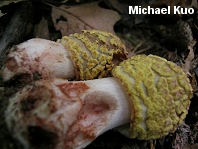
Blushing amanitas.
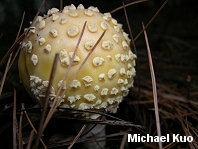
Cap with warts.
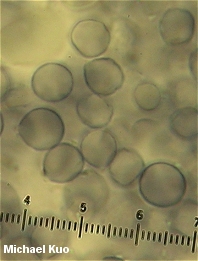
Round, amyloid spores
|
Key to 113 Amanitas in the United States and Canada 
| 1. | Stem base featuring a sacklike volva or a substantial flaring extension of volval tissue (be sure to dig up specimens carefully with a pocket knife). | 2 |
| 1. | Stem base without a sacklike volva. | 47 |
| 3. | Cap surface (independent of universal veil material) white or whitish overall. | 4 |
| 3. | Cap pigmented (some shade of red, orange, yellow, green, tan, or brown). | 14 |
| 4. | Found east of the Rocky Mountains. | 5 |
| 5. | Fresh specimens with a strong odor of garlic; southeastern in distribution. | |
| 5. | Fresh specimens without an odor of garlic; variously distributed. | 6 |
| 6. | Growing in sand on beaches or back dunes; known from northern Michigan. | |
| 6. | Growing in soil, in woods; variously distributed. | 7 |
| 7. | Ring ample and notably thickened; KOH on cap negative; spores ellipsoid; basidia 4-spored. | |
| 7. | Ring thin and fairly fragile; KOH on cap negative or yellow; spores globose or ellipsoid; basidia 2- or 4-spored. | 8 |
| 8. | Mature gills pinkish buff to pinkish or orangish. | 9 |
| 8. | Mature gills white or, when beginning to decay, slightly yellowish. | 10 |
| 9. | Cap margin not lined; spores amyloid; described from North Carolina. | |
| 9. | Cap margin lined; spores inamyloid; known from southeastern Canada, New Hampshire, and Maine. | |
| 10. | Cap usually featuring patches of universal veil material; cap margin appendiculate with hanging veil material; ring very fragile, usually only present in young specimens. | 11 |
| 10. | Cap only rarely with patches; cap margin not appendiculate; ring usually persisting to maturity. | 12 |
| 11. | Mature cap 2.5-5 cm across; odor not distinctive; spores 9-13 µ long. | |
| 11. | Mature cap 5-12 cm across; odor strong, reminiscent of rotting meat; spores 13-20 µ long. | |
| 12. | Spores globose or subglobose; basidia 2-spored, at least in summer; KOH yellow on cap surface. | |
| 12. | Spores ellipsoid; basidia 4-spored; KOH reaction not recorded (possibly negative). | 13 |
| 13. | Spores 12-14 x 5-6.5 µ. | |
| 14. | Cap a shade of green when fresh, fading to brownish or bronze; found associated with oaks in California or in eastern North America from Pennsylvania and Virginia to Maine. | |
| 14. | Cap not green; variously distributed. | 15 |
| 15. | Fresh cap tan to brown. | 16 |
| 16. | Found in northern California and the Pacific Northwest. | 17 |
| 16. | Found east of the Rocky Mountains. | 18 |
| 17. | Cap brown to gray-brown; stem with a water-soaked appearance; ring fragile and dissolving into the stem with age; spores 10-14 x 6.5-9 µ. | |
| 17. | Cap, when brown, usually a shade of yellow-brown; stem and ring not as above; spores 9-12 x 6-7 µ. | |
| 18. | Cap margin prominently lined about halfway to the center; cap not streaked in appearance; volva fairly tightly attached to stem base. | |
| 18. | Cap margin not lined, or faintly lined for a few mm at maturity; cap streaked in appearance; volva often flaring outwards and lobed. | |
| 19. | Fresh cap bright red to bright reddish orange. | 20 |
| 19. | Fresh cap a shade of yellow, brownish orange, or yellowish orange (red shades absent). | 21 |
| 20. | Found east of the Rocky Mountains, or in eastern Texas. | |
| 20. | Found in western North America. | |
| 21. | Found east of the Rocky Mountains. | 22 |
| 21. | Found in western North America. | 23 |
| 22. | Mature cap 4–10 cm across; most spores 9–12 µm long; distributed east of the Great Plains from roughly I-70 northward. | |
| 22. | Mature cap 8–15 cm across; most spores 8–10 µm long; distributed east of the Great Plains from roughly I-70 southward. | |
| 23. | Found in fall and winter; cap brownish yellow to bronze-yellow; odor not distinctive. | |
| 23. | Found in spring; cap clear yellow to pale yellow; odor often fishy. | |
| 24. | Found in western North America. | 25 |
| 24. | Found east of the Rocky Mountains. | 34 |
| 25. | Cap not brown to gray (orange, pale orange, pinkish orange, brassy orange, orangish tan, pale tan, white or whitish, straw colored, or dull yellow). | 29 |
| 26. | Cap dark brown when young and fresh; mushroom very large (mature cap 7-18 cm, stem 10-25 cm); known from the Pacific Northwest and northern California. | |
| 26. | Cap grayish brown to gray; mature mushroom smaller than above; variously distributed. | 27 |
| 27. | Cap usually lacking patches or warts; volva sturdy and persistent, but not flared abruptly. | |
| 27. | Warts or patches often present; volva sturdy and persistent, flaring or not--or fragile and breaking apart. | 28 |
| 28. | Volva flaring abruptly and distinctively outwards. | |
| 28. | Volva not flaring outwards abruptly, but often breaking up into patches and bands and/or forming a collarlike cup around the stem base. | |
| 29. | Found above treeline under dwarf willows in the northern Rocky Mountains; cap whitish to pale orangish or pale pinkish brown, with small patches of universal veil. | Amanita groenlandica f. alpina |
| 29. | Not completely as above. | 30 |
| 30. | Fresh cap white; stem and volva white. | Amanita vaginata var. alba |
| 30. | Fresh cap a shade of orange, orangish buff, or tan; stem and volva white or more highly colored. | 31 |
| 31. | Growing under coast live oak in spring; cap orangish buff to dull orange, usually adorned with one or more large patches. | |
| 31. | Growing under different trees in summer, fall, or winter; cap variously colored, typically without patches or with small warts. | 32 |
| 32. | Stem covered with orange fibrils that often become arranged into chevrons; cap pale orange, without patches or warts. | |
| 32. | Stem not as above; cap tan to yellowish, or brassy orange to orangish tan. | 33 |
| 33. | Volva fragile, often collapsing or breaking apart with maturity; cap pale tan to dirty yellowish or nearly whitish when faded; under cottonwoods or aspens in riparian ecosystems. | |
| 33. | Volva sturdy, remaining sacklike; cap brassy orange to orangish tan; under aspens at higher elevations. | |
| 34. | Fresh cap surface (independent of universal veil material) white or whitish overall (perhaps with a pale brownish center). | 35 |
| 34. | Cap surface more highly colored: a shade of brown, tan, gray, orange, or yellow. | 39 |
| 35. | Cap margin strongly lined, not "appendiculate" with overhanging veil material; cap surface usually lacking warts or patches; spores inamyloid. | Amanita vaginata var. alba |
| 35. | Cap margin not lined or only weakly lined, appendiculate; cap surface with warts and/or patches; spores amyloid. | 36 |
| 36. | Universal veil pinkish, resulting in pinkish warts or patches on the cap, and a pinkish volva. | Amanita peckiana |
| 36. | Universal veil material not pinkish. | 37 |
| 37. | Known from the Gulf Coast and the Carolinas; volva often fragile; spores 12-20 x 3.5-5 µ. | |
| 37. | Variously distributed; volva sturdy (persistently sacklike or with an extension of tissue); spores generally under 11 µ long. | 38 |
| 38. | Volva tightly adherent to stem base, except for an extension of tissue at the top of the bulb; cap whitish overall; cap margin not lined. | |
| 38. | Volva sacklike; cap often with a slightly brownish center; cap margin sometimes becoming somewhat lined. | |
| 39. | Stem covered with orange fibrils that often become arranged into chevrons; cap pale orange, without patches or warts. | |
| 39. | Stem not as above; cap not pale orange; warts or patches present or not. | 40 |
| 40. | Mushroom very large (stem 15-20 cm long and up to 2 cm wide; cap 7-10 cm across); cap yellowish olive; stem often hairy with brown to gray fibrils; found in northeastern North America. | |
| 40. | Mushroom small to medium in size; cap color varying; stem varying; variously distributed. | 41 |
| 41. | Mature mushrooms very small (cap usually well under 5 cm across). | 42 |
| 41. | Mature mushrooms larger than above. | 43 |
| 42. | Cap gray throughout development. | |
| 42. | Cap brown at first, becoming grayish brown or brownish. | |
| 43. | Associated with birch or willows in far northern, subarctic ecosystems; cap straw yellowish, with grayish patches. | |
| 43. | Not completely as above. | 44 |
| 44. | Volva fragile, often collapsing or breaking apart with maturity; cap pale tan to dirty yellowish or nearly whitish when faded; under cottonwoods or aspens in riparian ecosystems; possibly limited in range to Kansas, the northern Midwest, and the northeast. | |
| 44. | Volva sturdy, remaining sacklike; cap differently colored; ecology varying. | 45 |
| 45. | Cap tawny brown to reddish brown or orangish brown. | |
| 45. | Cap differently colored. | 46 |
| 46. | Cap brown to grayish brown to gray. | |
| 46. | Cap "Chinese yellow" to olive yellow or olive tan. | |
| 47. | Flesh and surfaces (especially the stem surface) staining and/or bruising pink to reddish. | 48 |
| 47. | Neither flesh nor surfaces staining or bruising pink to reddish. | 57 |
| 48. | Found in the southwestern United States, or on the West Coast. | 49 |
| 48. | Found east of the Rocky Mountains. | 50 |
| 49. | Cap and universal veil material whitish at first, becoming pink to pinkish tan. | |
| 49. | Cap and veil material bright yellow. | |
| 50. | Cap surface not bright yellow; veil material yellow or not. | 51 |
| 51. | Fresh cap surface white to whitish before reddish staining. | 52 |
| 51. | Fresh cap more highly colored. | 54 |
| 52. | Veil remnants absent from cap surface, or present as an inconspicuous patch; volva as a tiny extension or roll of tissue; spores 10-15+ x 6-8+ µ. | |
| 52. | Veil remnants present on cap as multiple warts; volva indistinct, or as vague ringlets of tissue; spores smaller than above. | 53 |
| 53. | Basal bulb roundish; volva indistinct; ring remaining whitish, or discoloring slightly yellowish. | |
| 53. | Basal bulb elongated; volva as loosely concentric circles of veil material; ring usually discoloring pink. | |
| 54. | Cap chocolate brown to brown, covered with large brown warts; mature cap margin "appendiculate" with overhanging veil material; stem base rooting; distributed from Florida to Texas. | |
| 54. | Cap variously colored but not chocolate brown; cap margin not appendiculate; stem base not rooting; variously distributed. | 55 |
| 55. | Basal bulb with a chiseled or split upper edge; cap grayish brown to pale brownish, often with a streaked or mottled appearance; warts absent, or scattered and few. | |
| 55. | Basal bulb not as above; cap tan, yellow-brown or bronze, not streaked or mottled; warts varying. | 56 |
| 56. | Cap surface dull yellowish to dull brown, often becoming bronze colored; warts plentiful, at first yellow, fading to pinkish or grayish; volva indistinct. | |
| 56. | Cap surface tan at maturity; universal veil material absent from cap, or present as an inconspicuous patch; volva as a tiny extension or roll of tissue. | |
| 57. | Cap a shade of red, orange, or yellow. | 58 |
| 57. | Cap differently colored. | 77 |
| 58. | Found in western North America or in the Rocky Mountains. | 59 |
| 58. | Found east of the Rocky mountains. | 63 |
| 59. | Cap bright red, with yellow to white warts; stem base swollen, adorned with prominent, concentric rings of shagginess. | |
| 59. | Cap not bright red; warts present or not, variously colored; stem base not as above. | 60 |
| 60. | Fresh cap sticky and dull medium yellow, with easily removed white warts; stem base with a free rim or roll of veil. | |
| 60. | Not completely as above. | 61 |
| 61. | Growing in lawns and grassy areas without apparent association with trees; cap whitish to grayish at first, sometimes becoming pale orange or pale yellow with age; stature squatty and reminiscent of some species of Agaricus. | |
| 61. | Growing in woods; cap not as above; stature varying. | 62 |
| 62. | Cap brown to yellow-brown when fresh, only rarely becoming yellow or bright yellow; lower stem and stem base with patches of yellow veil material; ring usually skirtlike and persistent. | |
| 62. | Cap bright orangish yellow when fresh, fading to dull orange; stem base with whitish rolls or rings of veil material; ring often collapsing or disappearing. | |
| 63. | Odor strong, foul, and distinctive (reminiscent of chlorine and/or rotten meat and/or urine); cap margin "appendiculate" with overhanging veil material; cap surface, beneath the veil remnants, actually whitish, but veil material reddish to orangish. | 64 |
| 63. | Odor not as above; cap margin not appendiculate (with one exception); cap surface, independent of veil material, red to orange or yellow. | 65 |
| 64. | Found naturally from Florida to Texas, growing in grassy areas or disturbed ground, without apparent mycorrhizal association--but sometimes appearing in botanical gardens and greenhouses; stem base not swollen, not rooting; odor foul but lacking a chlorine component. | |
| 64. | Found in woods, associated with trees, from the Great Lakes southward; stem base swollen and rooting; odor usually with a chlorine component. | |
| 65. | Stem base swollen, and ringed with concentric felty zones of shagginess; mature cap large (5-20 cm across). | 66 |
| 65. | Stem base not swollen--or, if swollen, not ringed with concentric felty zones; mature cap small to large. | 68 |
| 66. | Cap bright red when fresh; warts yellow, fading to whitish; found in northeastern North America, but absent or very rare in the Midwest and in the southeastern United States. | |
| 66. | Fresh cap a shade of orange or yellow; warts variable; variously distributed. | 67 |
| 67. | Cap reddish orange to peach orange, fading to orangish yellow; zones on stem base often fragile and fragmenting; found under conifers from the southeastern United States to New York. | |
| 67. | Cap orange to yellow; zones on stem base well developed and persistent; found under hardwoods or conifers east of the Great Plains. | |
| 68. | Cap dull yellowish tan, sometimes becoming yellowish with age; stem base swollen; volva remnants as a poorly defined ring or smear of material on the bulb; known distribution from Pennsylvania to Maine. | |
| 68. | Not completely as above. | 69 |
| 69. | Stem base not swollen, or only slightly swollen; universal veil leaving indistinct remnants on the stem base, or leaving patches and fragments of material that is easily shed and easily lost when the mushroom is picked. | 70 |
| 69. | Stem base swollen into a prominent bulb; universal veil leaving a gutter or roll of tissue on the upper edge of the bulb. | 73 |
| 70. | Partial veil absent (young gills not covered; ring never present); cap red to reddish orange; cap margin becoming prominently lined at maturity; gills pale yellow. | |
| 70. | Partial veil present (young gills covered; ring present at least when young); cap pinkish orange, orange, or yellow; cap margin not becoming lined, or only slightly so; gills white or pale yellow. | 71 |
| 71. | Cap pinkish orange, initially covered with powdery veil material that may later become aggregated into warts or patches; young cap margin often featuring veil remnants; ring quickly disappearing; stem base slightly swollen. | |
| 71. | Cap orange to yellow, without veil remnants or with a few warts or patches; young cap margin not as above; ring persistent; stem base even. | 72 |
| 72. | Stem pale yellow; cap orange to orangish yellow or, when faded or in direct sun, yellow; widely distributed east of the Great Plains. | |
| 72. | Stem white; cap usually clear yellow; distributed from South Carolina to the maritime provinces. | |
| 73. | Cap pale greenish yellow, fading to nearly whitish; grayish to lavender patches usually present on cap surface; spores amyloid. | |
| 73. | Cap differently colored; patches or warts absent or present; spores inamyloid. | 74 |
| 74. | Cap mostly white, with a yellowish to yellow center, adorned with white warts; cap margin becoming prominently lined. | |
| 74. | Cap differently colored; warts varying; cap margin becoming lined or not. | 75 |
| 75. | Fresh cap bright yellow to bright orangish yellow, with yellow warts; distributed from New York to the maritime provinces. | |
| 75. | Cap dull yellow to creamy yellow or brownish yellow; variously distributed. | 76 |
| 76. | Cap margin strongly lined; warts scattered, not numerous; mature cap 3-9 cm across. | |
| 76. | Cap margin not lined; warts numerous and concentrically arranged, at least when young; mature cap 5-18 cm across. | |
| 77. | Cap a shade of gray, tan, or brown. | 78 |
| 77. | Cap not gray, tan, or brown. | 98 |
| 78. | Cap margin "appendiculate" with overhanging universal veil remnants; stem base rooting; odor often strong and distinctive; spores amyloid. | 79 |
| 78. | Cap margin not appendiculate; stem base not rooting; odor varying but not usually strong; spores amyloid or inamyloid. | 83 |
| 79. | Cap surface gray, covered with dark gray warts; stem base with bent-back scales and/or concentric zones of universal veil material; mature mushroom small to medium in size (cap 4.5-6 cm). | |
| 79. | Cap surface and warts or patches varying; stem base without bent-back scales; size varying. | 80 |
| 80. | Cap and stem very pale gray; gills becoming pale brownish (the color of café au lait); stem base staining bluish to greenish. | |
| 80. | Cap and stem color varying; gills not becoming brownish; stem base not staining bluish to greenish. | 81 |
| 81. | Universal veil creating a roll or limb of volval tissue on the upper edge of the stem base; cap pale gray, becoming brownish with age; spores 11.5-16 x 4-5 µ; distributed in coastal areas from New York to Florida to Texas. | |
| 81. | Stem base without a roll or limb of volval tissue; cap gray, with or without a brownish center; spores shorter and wider than above; variously distributed in eastern North America. | 82 |
| 82. | Cap 10-17 cm across at maturity, covered with discrete, non-powdery warts; stem whitish and not powdery, with yellow to orangish fibrils. | |
| 82. | Cap 3-9 cm across at maturity, covered with a powdery layer of veil material that forms powdery warts; stem powdery and grayish. | |
| 83. | Partial veil present (young gills covered; ring present, at least when young). | 86 |
| 84. | Cap medium to dark brown, with grayish patches or warts; universal veil leaving gray flakes or patches of material on stem base. | |
| 84. | Cap gray to pale grayish brown, with a powdery to mealy covering that sometimes aggregates into small, powdery patches or warts; universal veil leaving a smear of gray on the upper edge of a small basal bulb. | 85 |
| 85. | Found east of the Rocky Mountains; stem usually under 1 cm thick. | |
| 85. | Found on the West Coast; stem 1-2 cm thick. | |
| 86. | Universal veil leaving yellow bands, patches, or fragments on the lower stem, stem base, and/or the surrounding substrate. | 87 |
| 86. | Universal veil remnants on lower stem, if present, not yellow. | 88 |
| 87. | Found east of the Rocky Mountains; cap medium to dark grayish brown with yellow warts. | |
| 87. | Found in the Pacific Northwest and northern California; cap golden brown to yellow brown, with dull yellowish warts. | |
| 88. | Found in Alaska and possibly in far northern Canada; stem base swollen, and ringed with concentric felty zones of shagginess; cap surface brown, with many yellowish to grayish warts. | |
| 88. | Found elsewhere; stem base not as above; cap varying. | 89 |
| 89. | Found in western North America under conifers; stem base swollen, featuring a band or roll of universal veil tissue on the upper margin of the bulb; cap with whitish warts. | |
| 89. | Not completely as above. | 90 |
| 90. | Mature cap under 4.5 cm across. | 91 |
| 90. | Mature cap larger than above. | 92 |
| 91. | Associated with oaks; cap pale brown to grayish brown, streaked in appearance; odor not distinctive. | |
| 92. | Stem terminating in a large, abrupt basal bulb that has a clearly defined upper edge or rim. | 93 |
| 92. | Stem base not as above (if terminating in a large bulb, the bulb is egg-shaped or roundish, without an upper edge). | 94 |
| 93. | Associated only with conifers; cap grayish brown to purplish brown; stem with grayish to brownish fibrils; ring grayish; stem surface and flesh not bruising. | |
| 93. | Associated with hardwoods or conifers; cap grayish brown to nearly whitish; stem whitish, lacking grayish to brownish fibrils; ring white; stem surface and flesh often bruising reddish brown to brown. | |
| 94. | Partial veil and universal veil pinkish beige and powdery, resulting in a pinkish beige ring, and pinkish beige patches or powdery coating on cap and base of stem. | |
| 94. | Veils not pinkish beige. | 95 |
| 95. | Cap dull yellowish tan, not streaked; warts plentiful; stem base swollen; volva remnants as a poorly defined ring or smear of material on the bulb; known distribution from Pennsylvania to Maine. | |
| 95. | Not completely as above. | 96 |
| 96. | Cap radially streaked; ring ample, often positioned at extreme apex of stem; stem base with gray to whitish fragments of veil material; odor often fruity. | |
| 96. | Cap not streaked; ring not apical; veil remnants on stem base varying; odor fruity or not. | 97 |
| 97. | Northeastern in distribution; ring narrow and flimsy, developing a pale orangish tint; odor fruity; found in moist soils near swamps and bodies of water. | |
| 97. | Not completely as above. | One to several poorly understood species often given the European name" Amanita spissa" at Roger's Mushrooms |
| 98. | Growing in grassy areas without mycorrhizal association with trees (in lawns, pastures, meadows, on prairies, and so on). | 99 |
| 98. | Growing as mycorrhizal associates with trees in various ecosystems (and sometimes in lawns where trees are present). | 103 |
| 99. | Known from coastal California and coastal Oregon; stature often short and squat. | |
| 99. | Variously distributed; stature not usually short and squat. | 100 |
| 100. | Cap with a powdery, sticky white covering of universal veil material but without firm, clearly defined warts; distributed from Texas to Kansas and Ohio. | |
| 100. | Cap bald, or with prominent warts; distributed from Kansas westward. | 101 |
| 101. | Cap usually bald, or with a few small patches; odor strong and medicinal; distributed from Alberta to Colorado. | |
| 101. | Cap with prominent warts or patches; odor not distinctive, or becoming foul when mature; potentially distributed throughout western North America. | 102 |
| 102. | Cap soon with tawny, orangish brown to pinkish brown scales; stem proportionally slender (6–12 x 1–2 cm), sheathed with orangish brown scales; spores broadly ellipsoid. | |
| 102. | Cap with brownish to brown scales; stem a bit stubbier than above (4–8 x 1–2.5 cm), with scattered whitish to slightly brownish scales; spores often long-ellipsoid. | |
| 103. | Found west of the Great Plains. | 104 |
| 103. | Found east of the Rocky Mountains. | 108 |
| 104. | Stem base swollen but not elongated lengthwise, adorned with prominent, concentric rings of shagginess, not rooting; cap with plentiful, small and firm (not powdery) warts; spores inamyloid. | |
| 104. | Not completely as above. | 105 |
| 105. | Stem base featuring a band or roll of universal veil tissue on the upper margin of the bulb; universal veil material not powdery; spores inamyloid. | |
| 105. | Stem base not as above; universal veil powdery or not; spores amyloid. | 106 |
| 106. | Cap with very large, firm, pyramid-shaped warts; surfaces often bruising or discoloring brownish; distributed from northern California to Baja California. | |
| 106. | Warts if present small, soft, and powdery; surfaces not bruising brownish; distributed from northern California northward. | 107 |
| 107. | Stem base club-shaped or widely spindle-shaped, rooting; odor sometimes unpleasant; spores 8.5-12 x 6-8 µ. | |
| 107. | Stem base with an abrupt bulb that often features a rim on its upper edge, not rooting; spores 7-10 x 4-6 µ. | |
| 108. | Stem base very abruptly swollen, with a flattened upper edge (reminiscent of an egg that has been sliced off and stuck on the end of the stem); cap with numerous firm, non-powdery warts. | |
| 108. | Stem base not as above; warts if present varying. | 109 |
| 109. | Mature gills brownish (the color of café-au-lait). | 110 |
| 109. | Mature gills white to whitish. | 111 |
| 110. | Stem base staining bluish to greenish blue. | |
| 110. | Stem base not staining blue. | |
| 111. | Partial veil and universal veil pinkish beige and powdery, resulting in a pinkish beige ring, and pinkish beige patches or powdery coating on cap and base of stem; mature cap 3-7 cm across; spores inamyloid. | |
| 111. | Veils not pinkish beige--or if so, veil not powdery, spores amyloid, and mature cap larger than above. | 112 |
| 112. | Stem base with an abrupt bulb that is distinctively vertically split or "chiseled"; stem surface bruising brownish to reddish brown (sometimes slowly); spores amyloid and globose. | 113 |
| 112. | Stem base not as above; stem surface bruising or not; spores varying. | 114 |
| 113. | Cap with faintly brownish pigments, with a radially streaked appearance. | |
| 113. | Cap white (sometimes with a pale yellowish center), not streaked. | |
| 114. | Stem base with either a gutter-like or collar-like roll of tissue on the upper edge of the bulb, or with a small, free extension of volval tissue. | 115 |
| 114. | Stem base with neither a roll nor a free extension of tissue. | 120 |
| 115. | Stem base with either a gutter-like or collar-like roll of tissue; cap margin not "appendiculate" with overhanging veil material; spores amyloid or inamyloid. | 116 |
| 115. | Stem base with a free (not rolled) extension of tissue; cap margin often appendiculate, at least when young; spores amyloid. | 118 |
| 116. | Cap greenish to whitish, with a few grayish to lavender patches, or without veil remnants; odor sometimes potato-like; spores amyloid and globose. | |
| 116. | Cap not greenish; universal veil on cap as numerous warts; odor not distinctive; spores inamyloid. | 117 |
| 118. | Ring present and persistent; stem base often deeply rooting; spores 11.5-16 x 4-5 µ. | |
| 118. | Ring absent or if present quickly disappearing; stem base not rooting, or only slightly rooting; spores 9-12.5 x 4-6 µ. | 119 |
| 119. | Cap 2.5-5 cm across; spores 4.5-7 µ wide. | |
| 119. | Cap 4-9 cm across; spores 4-5 µ wide. | |
| 120. | Odor strong, reminiscent of garlic; known from Florida. | |
| 120. | Odor varying from not distinctive to strong and foul (reminiscent of rotting meat), or weakly to strongly of chlorine--but not reminiscent of garlic; variously distributed. | 121 |
| 121. | Stem base swollen but not elongated lengthwise, adorned with prominent, concentric rings of shagginess, not rooting; cap with whitish to tan warts; stem often bruising yellowish, then slowly brownish; northern in distribution; spores inamyloid. | |
| 121. | Stem base not as above; warts if present variable; stem not bruising as above; variously distributed; spores amyloid. | 122 |
| 122. | Stem base covered with prominent bent-back scales; cap with numerous firm warts that may become brownish with age; ring ample and persistent; odor not distinctive. | |
| 122. | Stem base not as above; warts if present varying; ring persistent or not; odor usually distinctive (like chlorine, rotting meat, etc.). | 123 |
| 123. | Mushroom identifier is willing to accept that s/he is attempting to identify one of many similar and usually stinky species in the notoriously difficult subgenus Lepidella, and that microscopic examination may be required--and that many of the species are poorly understood and may be revised once DNA studies set their sights on this taxonomic area. | 124 |
| 123. | Mushroom identifier wants an easy identification. | Stinky Whitish Lepidella |
| 124. | Universal veil leaving clearly defined, raised, relatively thick, felty to hardened warts on cap surface (at least over the center). | 125 |
| 124. | Universal veil not as above; either thin and powdery, or a soft and flat layer that may become stretched out, resulting in flattened, large or small patches. | 132 |
| 125. | Spores narrowly ellipsoid or nearly cylindric (only 4-5 µ wide). | 126 |
| 125. | Spores ellipsoid (4.5-8 µ wide). | 127 |
| 126. | Found from Florida to Texas and New Jersey; cap often with pinkish hues; odor a combination of sweetish pungency and chlorine; cells from universal veil on cap infrequently clavate. | |
| 126. | Found from Florida to Texas and South Carolina; cap without pinkish hues; odor more simply chlorine-like; cells from universal veil remnants on cap often clavate. | |
| 127. | Basal bulb at maturity large and more or less round (above a short or long underground rooting portion); warts usually brown to reddish brown, pinkish brown, or orangish brown. | 128 |
| 127. | Basal bulb possibly proportionally large and round when young, but by maturity not as bulbous as above: either spindle-shaped and gradually swollen, or not swollen; warts usually whitish to grayish, grayish brown, yellowish brown, or brown. | 129 |
| 128. | Warts also present on stem base, fairly evenly spaced and covering bulb nearly to the ground; warts reddish brown; cap to 13 cm across. | |
| 128. | Veil remains on stem base less clearly defined and found primarily on the upper portion of the bulb; warts orangish brown to pinkish brown; cap to 25 cm across. | |
| 129. | Warts brownish gray to grayish brown. | 130 |
| 129. | Warts whitish to tan or brownish, without gray hues. | 131 |
| 130. | Distributed from the Carolinas northward; odor like bread dough, sometimes becoming chlorine-like with age; warts reminiscent of little patches of dried mud; bulb often (but not always) adorned with warts or patches of veil material. | |
| 130. | Distributed from the Carolinas to Texas; odor not distinctive; warts appearing like fuzzy to hairy scales; bulb rarely with clearly defined veil remains. | |
| 131. | Warts, at their bases, with radial grooves and fibers (use a hand lens); ring almost always disappearing by maturity; veil remnants often left in rings on bulb's upper edge. | |
| 131. | Warts not as above; ring delicate but often persisting to maturity; veil remnants on bulb usually indistinct. | |
| 132. | Cap surface white, but veil material (warts, patches, or powdery layer) gray. | |
| 132. | Cap surface white to whitish; veil material whitish. | 133 |
| 133. | Known from the Gulf Coast and the Carolinas; spores nearly cylindric (12-20 x 3.5-5 µ). | |
| 133. | Variously distributed; spores generally more ellipsoid than above (i. e., short and wider). | 134 |
| 134. | Mature cap 7-21 cm across; bulb large and club-shaped. | |
| 134. | Mature cap 2.5-10 cm across; bulb not as above (indistinct, elongated, or turnip shaped). | 135 |
| 135. | Spores narrowly ellipsoid or nearly cylindric (only 4-5 µ wide). | 136 |
| 135. | Spores ellipsoid (4.5-7 µ wide). | 137 |
| 136. | Found from Florida to Texas and New Jersey; cap often with pinkish hues; odor a combination of sweetish pungency and chlorine; cells from universal veil on cap infrequently clavate. | |
| 136. | Found from Florida to Texas and South Carolina; cap without pinkish hues; odor more simply chlorine-like; cells from universal veil remnants on cap often clavate. | |
| 137. | Spores 7-11 µ long; odor strong and foul--reminiscent of chlorine and rotting meat; stem not curved or bent, not rooting or only slightly rooting. | |
| 137. | Spores 10-14 µ long; odor not distinctive, or faintly like disinfectant but not unpleasant; stem often curved or bent, usually deeply rooting. | |
References
Ammirati, J. F., Thiers, H. D. & Horgan, P. A.. (1977). Amatoxin-containing mushrooms: Amanita ocreata and A. phalloides in California. Mycologia 69: 1095-1108.
Bas, C. (1969). Morphology and subdivision of Amanita and a monograph on its section Lepidella. Persoonia 5: 285-579.
Bas, C. (2003). A broader view on Amanita. Retrieved April 19, 2008 from the Gruppo Micologico 'G. Bresadola' Web site: http://www.mtsn.tn.it/bresadola/bgmb/bgmb_2000_2_bas.asp
Beardslee, H. C. (1914). Notes on a few Asheville fungi. Mycologia 6: 88-92.
Beardslee, H. C. (1919). A new species of Amanita. Journal of the Elisha Mitchell Scientific Society 34: 198–199.
Began, T. J. (1988). The genus Amanita in southern Illinois including cultural characters and a detailed study of volval anatomy in section Lepidella. MA Thesis, Southern Illinois University. Carbondale, IL. 127 pp.
Bojantchev, D., S. R. Pennycook & R. M. Davis (2011). Amanita vernicoccora sp. nov.--the vernal fruiting "coccora" from California. Mycotaxon 117: 485-497.
Bojantchev, D. & R. M. Davis (2013). Amanita augusta, a new species from California and the Pacific Northwest. North American Fungi 8: 1-11.
Bruns, T. D. et al. (2002). Survival of Suillus pungens and Amanita francheti ectomycorrhizal genets was rare or absent after a stand-replacing wildfire. New Phytologist 155: 517-523.
Coker, W. C. (1917). The amanitas of the eastern United States. Journal of the Elisha Mitchell Scientific Society 33: 1-88.
Cripps, C. L. & E. Horak (2010). Amanita in the Rocky Mountain alpine zone, USA: New records for A. nivalis and A. groenlandica. North American Fungi 5: 9-21.
Drehmel, D., Moncalvo, J. & Vilgalys, R. (1999). Molecular phylogeny of Amanita based on large-subunit ribosomal DNA sequences: implications for taxonomy and character evolution. Mycologia 91: 610-618.
Geml, J., A. Laursen, K. O'Neill, H. C. Nusbaum & D. L. Taylor (2006). Beringian origins and cryptic speciation events in the fly agaric (Amanita muscaria). Molecular Ecology 15: 225-239.
Guzman, G. (1981). Distribution of Amanita nauseosa. Mycotaxon 12: 522-524.
Hallen, H.E., H. Luo, J. S. Scott-Craig & J. D. Walton (2007). Gene family encoding the major toxins of lethal Amanita mushrooms. Proceedings of the National Academy of Science 104: 19097-19101.
Jenkins, D. T. (1978). A study of Amanita types I. Taxa described by C. H. Peck. Mycotaxon 7: 23-44.
Jenkins, D. T. (1978). A study of Amanita types II. A. ocreata Peck. Mycotaxon 7: 371-372.
Jenkins, D. T. (1979). A study of Amanita types III. Taxa described by W. A. Murrill. Mycotaxon 10: 175-200.
Jenkins, D. T. & Vinopal, J. (1979). A new Amanita from Florida. Mycotaxon 8: 177-180.
Jenkins, D. T. (1979). A new species of Amanita. Mycotaxon 8: 174-176.
Jenkins, D. T. (1980). A new species of Amanita. Mycotaxon 10: 296-298.
Jenkins, D. T. (1981). A new species of Amanita. Mycotaxon 13: 112-114.
Jenkins, D. T. (1982). A new species of Amanita. Mycotaxon 14: 233-236.
Jenkins, D. T. (1983). A new species of Amanita. Mycotaxon 16: 414-416.
Jenkins, D. T. (1984). A new species of Amanita IV. Mycotaxon 20: 315-317.
Jenkins, D. T. (1985). A new species of Amanita VII. Mycotaxon 24: 283-286.
Jenkins, D. T. (1986). Amanita of North America. Eureka, CA: Mad River Press. 198 pp.
Jenkins, D. T. (1988). A new species of Amanita from North America: Amanita levistriata. Mycotaxon 32: 415-419.
Largent, D. L., N. Sugihara & A. Brinitzer (1980). Amanita gemmata, a non-host-specific mycorrhizal fungus of Arctostaphylos manzanita. Mycologia 72: 435-439.
López, A. R. & J. García (2012). Amanita jacksonii. Funga Veracruzana 136.
Miller, O. K.. Jr., Trueblood, E. & Jenkins, D. T. (1990). Three new species of Amanita from southwestern Idaho and southeastern Oregon. Mycologia 82: 120-128.
Moncalvo, J. M., Drehmel, D. & Vilgalys, R. (2000). Variations in modes and rates of evolution in nuclear and mitochondrial ribosomal DNA in the mushroom genus Amanita (Agaricales, Basidiomycota): Phylogenetic implications. Molecular Phylogenetics and Evolution 16: 48-63.
Morales-Torres, E., M. Villegas, J. Cifuentes & R. E. Tulloss (1999). Revision of Amanita alexandri and its similarity to Amanita polypyramis. Mycotaxon 73: 477-491.
Murrill, W. A. (1913). The amanitas of eastern North America. Mycologia 5: 72-86.
Neville, P. & S. Poumarat (2004). Amaniteae: Amanita, Limacella & Torrendia. Fungi Europaei Vol. 9. Alassio, Italy: 1120 pp.
Oda, T., Tanaka, C. & Tsuda, M. Molecular phylogeny and biogeography of the widely distributed Amanita species, A. muscaria and A. pantherina. Mycological Research 108: 885-896.
Pringle, A., R. I. Adams, H. B. Cross & T. D. Bruns (2009). The ectomycorrhizal fungus Amanita phalloides was introduced and is expanding its range on the west coast of North America. Molecular Ecology 18: 817-833.
Redecker, D. et al. (2001). Small genets of Lactarius xanthogalactus, Russula cremoricolor, and Amanita franchetii in late-stage ectomycorrhizal successions. Molecular Ecology 10: 1025-1034.
Redhead, S. A., A. Vizzini, D. C. Drehmel & M. Contu (2016). Saproamanita, a new name for both Lepidella E.-J. Gilbert and Aspidella E.-J. Gilbert (Amaniteae, Amanitaceae). IMA Fungus 7: 119–129.
Sánchez-Ramírez, S. & 11 coauthors (2015). In and out of refugia: historical patterns of diversity and demography in the North American Caesar's mushroom species complex. Molecular Ecology 24: 5938–5956.
Stewart, H. L. & Grund, D. W. (1974). Nova Scotian fungi. New species and records of amanitas for the province. Canadian Journal of Botany 52: 331-379.
Thiers, H. D. 1982. The Agaricales of California. 1. Amanitaceae. Eureka, CA: Mad River Press.
Thiers, H. D. & Ammirati, J. F. (1982). New species of Amanita from western North America. Mycotaxon 15: 155-166.
Tulloss, R. E. (1984). Distribution and taxonomic notes on Amanita mutabilis. Mycologia 76: 555–558.
Tulloss, R. E. & Jenkins, D. T. (1986). Notes on distribution of Amanita albocreata. Mycotaxon 26: 81-83.
Tulloss, R. E. (1988). Amanita sinicoflava--a new species from eastern North America. Mycotaxon 32: 421-431.
Tulloss, R. E. (1989). Amanita eburnea--a new species from Central America. Mycotaxon 36: 1-7.
Tulloss, R. E. (1989). Amanita ristichii: A new species from New England with basidia dominantly 2-spored. Mycotaxon 35: 363-369.
Tulloss, R. E. & Wright, G. (1989). Amanita protecta--a new species from coastal southern California. Mycotaxon 34: 615-622.
Tulloss, R. E. (1990). Amanita crenulata--history, taxonomy, distribution, and poisonings. Mycotaxon 39: 393-405.
Tulloss, R. E. (1990). Amanita salmonescens--a new species from the southeastern United States. Mycotaxon 38: 125-132.
Tulloss, R. E. (1991). Amanita morrisii--history, taxonomy, and distribution. Mycotaxon 40: 281-286.
Tulloss, R. E. & Lindgren, J. E. (1992). Amanita smithiana--taxonomy, distribution, and poisonings. Mycotaxon 45: 373-387.
Tulloss, R. E., Ovrebo, C. E. & Halling, R. E. (1992). Studies on Amanita (Amanitaceae) from Andean Colombia. Memoirs of the New York Botanical Garden 66: 1-46.
Tulloss, R. E. (1993). Amanita pachysperma, Amanita subvirginiana, and Amanita virginiana (taxonomy and distribution) with notes on description of the lamella trama in Amanita. Mycotaxon 49: 449-475.
Tulloss, R. E. (1994). Type studies in Amanita section Vaginatae I: Some taxa described in this century (studies 1-23) with notes on description of spores and refractive hyphae in Amanita. Mycotaxon 52: 305-396.
Tulloss, R. E. & Lindgren, J. E. (1994). Amanita novinupta--a rubescent, white species from the western United States and southwestern Canada. Mycotaxon 51: 179-190.
Tulloss, R. E. & Lewis, D. P. (1994). Amanita westii--taxonomy and distribution. A rare species from the states bordering the Gulf of Mexico. Mycotaxon 50: 131-138.
Tulloss, R. E. (1995). Amanita longitibiale--A new species of Amanita section Phalloideae from central Mexico and southeastern U.S.A. Mycotaxon 54: 195-202.
Tulloss, R. E. & Moses, E. (1995). Amanita populiphila--a new species from the central United States. Mycotaxon 53: 455-466.
Tulloss, R. E., S. L. Stephenson, R. P. Bhatt & A. Kumar (1995). Studies on Amanita (Amanitaceae) in West Virginia and adjacent areas of the mid-Appalachians. Preliminary results. Mycotaxon 56: 243-293.
Tulloss, R. E. (2000). Nomenclatural changes in Amanita. Mycotaxon 75: 329-332.
Tulloss, R. E. & Lindgren, J. E. (2005). Amanita aprica--a new toxic species from western North America. Mycotaxon 91: 193-205.
Tulloss, R. E. (2009). Amanita magniverrucata--revision of an interesting species of Amanita section Lepidella. Mycotaxon 108: 93-104.
Tulloss, R. E., Th. W. Kuyper, E. C. Vellinga, Z. L. Yang, R. E. Halling, J. Geml, S. Sánchez-Ramírez, S. C. Conçalves, J. Hess & A. Pringle (2016). The genus Amanita should not be split. Amanitaceae 1: 1–16.
Tulloss, R. E. (continuously updated). Studies in the Amanitaceae. Retrieved in October, 2019 from: http://www.amanitaceae.org
Vesterholt, J. (2018). Amanita Pers. In Knudsen, H. & J. Vesterholt, eds. Funga Nordica: Agaricoid, boletoid, clavarioid, cyphelloid and gastroid genera. Copenhagen: Nordsvamp, 377–384.
Weiss, M., Yang, Z-L. & Oberwinkler, F. (1998). Molecular phylogenetic studies in the genus Amanita. Canadian Journal of Botany 76: 1170- 1179.
Wolfe, B. E., M. Kuo & A. Pringle (2012). Amanita thiersii is a saprotrophic fungus expanding its range in the United States. Mycologia 104: 22-33.
This site contains no information about the edibility or toxicity of mushrooms.
Cite this page as:
Kuo, M. (2013, June). The genus Amanita. Retrieved from the MushroomExpert.Com Web site: http://www.mushroomexpert.com/amanita.html
© MushroomExpert.Com
|

